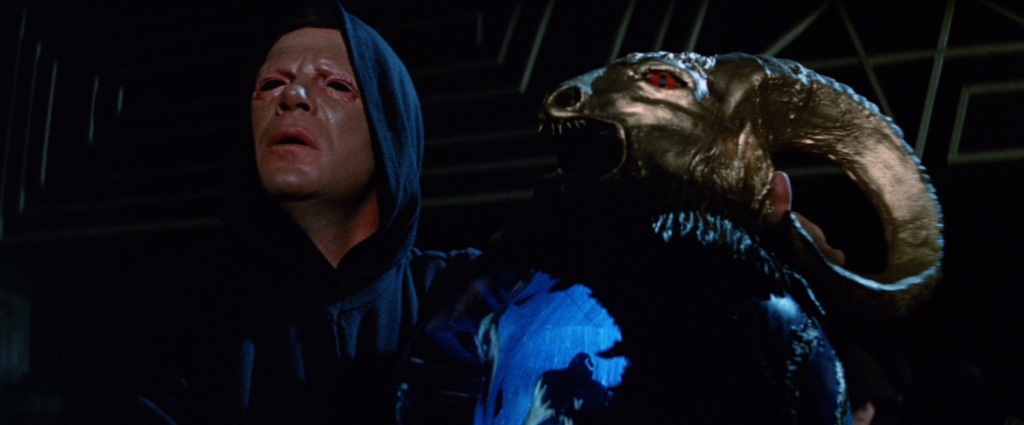
While “sheltering in place,” I’ve spent time working through stacks of films new to my collection from sales by labels like Shout/Scream Factory, Indicator, and Severin. (I’ve also been diving deep into Jonathan Rigby’s Euro Gothic, his follow-up to the excellent English Gothic and American Gothic horror surveys. I’ve enjoyed this book even more than the others, and it’s moving a number of Euro horror titles to the top of my watch list – many of which will inevitably wind up here.) Thanks to that Severin sale, a film I revisited earlier this week was the old favorite The Devil’s Rain (1975), the utterly mad Satanic thriller from the always-underrated oddball Robert Fuest (The Abominable Dr. Phibes, The Final Programme). Fuest’s films are often colorful and deeply imaginative, enlivened by satirical and camp tendencies. And here he provides not a run-of-the-mill 70’s Satanic cult movie, but a swing-for-the-fences attempt at the ultimate 70’s Satanic cult movie. Following opening credits over the comically grotesque details of Hieronymus Bosch’s work, and featuring the very prominent credit for Satanic technical consultant Anton LaVey, the story begins in medias res in the most bewildering way imaginable, as though we’ve just walked into the season finale of a William Shatner TV series – one featuring guest star Ida Lupino as his mother. What seems to be an insane prologue (a voodoo doll in Shatner’s car; his father suddenly strung up from the ceiling; a death by melting into goo in the rain; something-something about a book) just keeps going. Shatner drives to a Wild West ghost town and encounters Ernest Borgnine as the demonic Jonathan Corbis, who leads him into a church occupied by hooded cloak-wearing cultists with eyeless zombie faces. Shatner offers up his faith against Borgnine’s, which involves stripping shirtless and getting a pentagram tattoo on his chest. Following the lead of Psycho – I guess – the story then switches focus to Shatner’s brother, played by Tom Skerritt (in a very early role), who travels with psychic Joan Prather to the town to confront Borgnine and his family’s ancestral secret. As if this and a plethora of melting faces weren’t enough, the film also features Eddie Albert, Keenan Wynn, and – in his first big-screen appearance – John Travolta. The plot eventually gains some necessary exposition with a flashback depicting the origins of the family curse, but I’m not sure anyone ever bothers to explain the diabolical and deeply silly deluge, which is so important to the climax.
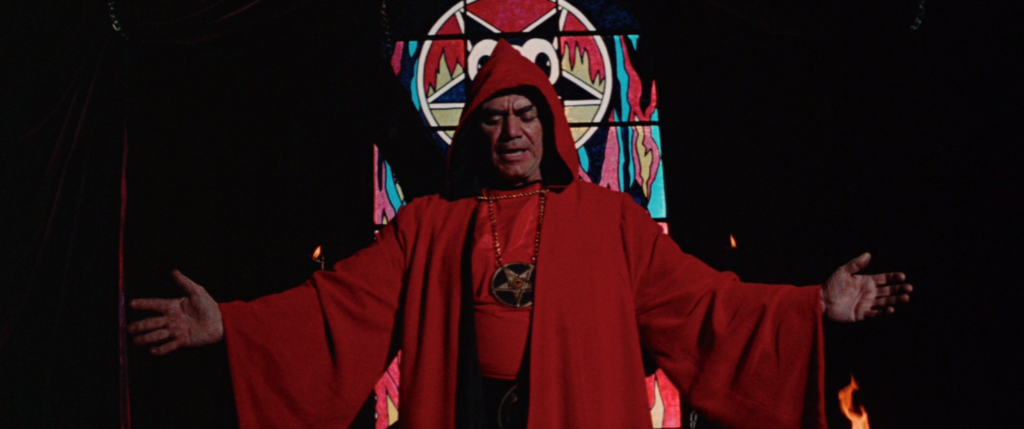
Ernest Borgnine presides over his Satanic flock in “The Devil’s Rain.”
The 2017 Severin Blu-ray may feature the most entertaining special features I’ve ever had the pleasure to watch. In an interview with Skerritt, he bursts into laughter when informed by the interviewer that Anton LaVey was on the set to lend authenticity: “For The Devil’s Rain?!” SFX artist Tom Burman details the process for the face-melting effects, but also dishes dirt on Lupino and Shatner. Script supervisor Ana Maria Quintana, who would go on to a career with much more impressive credits, tells some wonderful stories of filming in Mexico – this was her very first film, and she confesses she had no idea what she was doing. Two featurettes detail the involvement of Anton LaVey (from his former partner and biographer Blanche Barton, and the current High Priest and Priestess of the Church of Satan); LaVey really was on set, creating phonetic cue cards for the Mexican extras to chant, though we get conflicting reports of how he felt about the final product. Perhaps most amusing is a vintage interview with Shatner in which he expresses reluctance to make a Star Trek movie, citing the TV pilots he has lined up and this new project he’s got coming out called The Devil’s Rain, which he insists will be very scary. Making a Star Trek feature film “might be a step backward,” he muses.
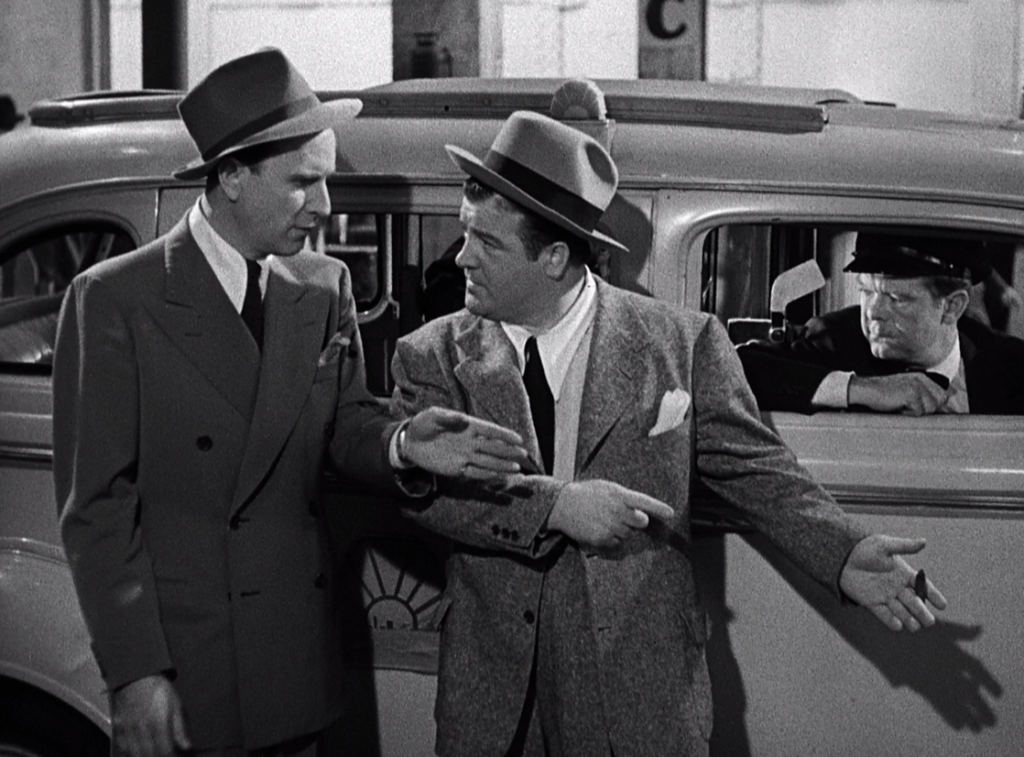
Abbott and Costello’s “Who’s on First,” as presented in “One Night in the Tropics” (1940).
I also got my hands on Shout Factory’s Abbott and Costello: The Complete Universal Pictures Collection (80th Anniversary Edition). Abbott and Costello movies were favorites of mine as a child, though the only films of theirs I’ve revisited with any regularity are Abbott and Costello Meet Frankenstein (1948) and a non-Universal movie I love, Lost in a Harem (1944), which is like the A&C take on Road to Morocco. I thought this comprehensive 28-film box set of their Universal catalog might take me years to get through – like certain other giant sets I’m slowly working on, as they glare at me from the shelf – but at least for the first three movies I’m eating these like candy. The one that’s been a real surprise so far is One Night in the Tropics (1940), which tends to get dismissed because it’s not a proper A&C movie – they’re supporting characters to singer Allan Jones (veteran of the Marx Brothers films A Night at the Opera and A Day at the Races) and comedian Robert Cummings, later of the 50’s TV comedy The Bob Cummings Show; not to mention female leads Nancy Kelly and Peggy Moran. And indeed it’s hard not to feel a small sigh of disappointment as the film starts with an extended introduction to Jones and Cummings, no “Heeey Abbott!” in sight. But this is a screwball comedy with a bit of that WWII keep-the-troops-entertained, variety show sensibility, and the screwball – though not matching the heights of a Sturges or Lubitsch – is very funny. All of the leads are a total delight, even if the plot (involving taking out “love insurance”) is perfunctory. As for A&C, they show up early and appear in about every other scene, delivering some of their best material, including a version of “Who’s on First” with the freshness and energy of two radio stars finally getting a chance to capture this prized bit for the silver screen. I don’t think it’s sacrilege to say this is a great place to start if you’re new to A&C. Buck Privates (1941) and its expedited follow-up, In the Navy (1941), put the duo front and center, albeit sharing screen time with wartime icons The Andrews Sisters, who sing “The Boogie Woogie Bugle Boy” in the former film (a great performance, it must be said). The latter film suffers from an unengaging Dick Powell as a sex symbol crooner fleeing from fame by enlisting under a pseudonym, with investigative reporter Claire Dodd in pursuit. The best bit here is A&C’s extended mathematical magic trick, “7×13=28.”
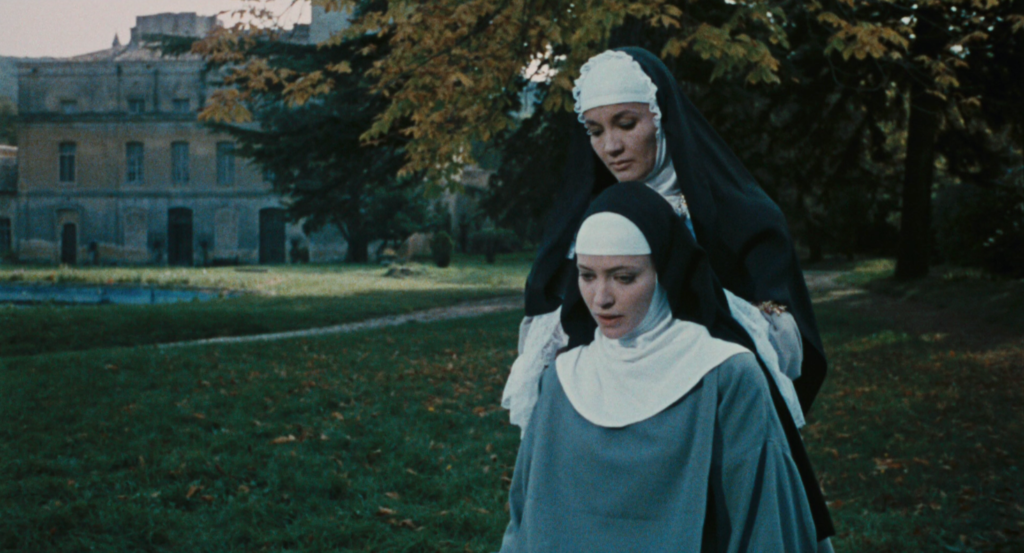
Liselotte Pulver develops an unholy obsession for Anna Karina in Jacques Rivette’s “The Nun” (1966).
The downtime has also allowed me to revisit Jacques Rivette’s once-controversial Diderot adaptation, The Nun (La religieuse, 1966), released by Kino and StudioCanal from a 4K restoration last year. Anna Karina recreates her stage role, and the performance is one of her very best: she’s Suzanne Simonin, a woman forced into a convent for the sin of being the product of her mother’s extramarital affair – and for being physically attractive, creating consternation in the household when it’s her sisters who stand to inherit the family fortune, and therefore ought to be the ones attracting suitors. Angered that the law is cloistering her when she doesn’t feel any calling to the faith, she soon comes into conflict with the domineering, fiercely jealous mother superior (Francine Bergé) who takes command of the convent soon after she arrives. Playing a game of domestic politics against her will – and even engaging a lawyer to have the mother superior removed by the Church – she eventually manages to escape to another institution, only to encounter an entirely different kind of corruption in power. Madame de Chelles (Liselotte Pulver) showers Suzanne with affection, and boasts of her convent’s relaxed policies, but her assurance that Suzanne’s suffering has come to an end comes with unwelcome and increasingly aggressive sexual overtures. The Nun is unlike any other film in Rivette’s oeuvre, and perhaps his most commercial film – he would strip down his technique and venture into more experimental avenues next. But if it’s an outlier, it’s also a stunner, flirting with the Gothic horror genre and featuring an avant-garde soundtrack by Jean-Claude Eloy that summons feelings of dread, claustrophobia, and panic. The scenes with Pulver are also outrageously funny – before they become, intentionally, uncomfortable, only enhanced in this post-Me Too era. Much more than an indictment of religion, The Nun is about how those in a position of power are compelled to selfishly exploit it; the source is Diderot, but there’s a touch of De Sade here too. The film was initially banned in France, while Jean-Luc Godard and others led the charge to demand its release, which turned it into a belated commercial hit. I fell for this film during a Rivette retrospective many years ago, so I was grateful to finally see it get a physical release.
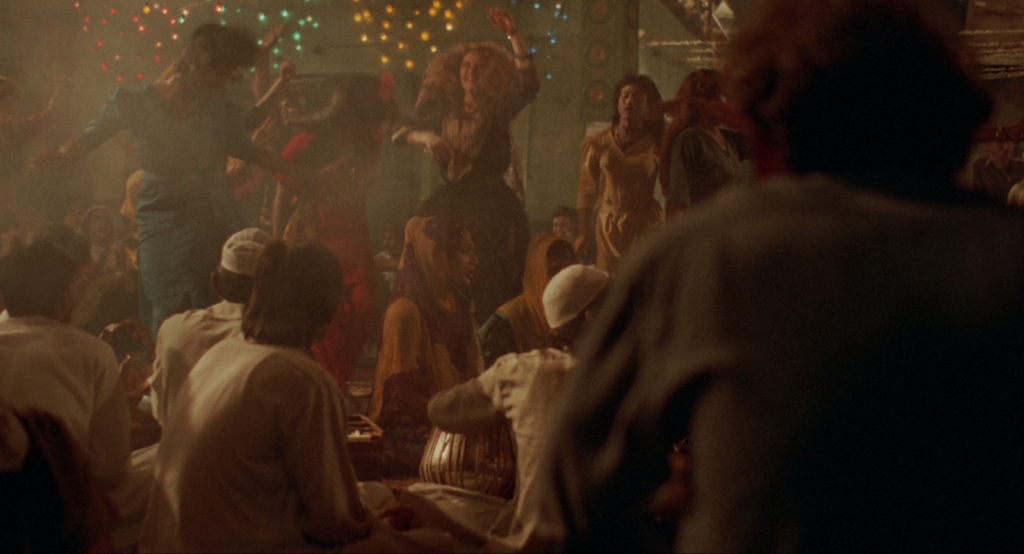
Melissa Leo dances with the eunuchs while James Wilby watches in “Immaculate Conception” (1992).
I came to another searing drama, Jamil Dehlavi’s Immaculate Conception (1992), through Indicator’s recent Blu-ray after I was wowed by their release of Dehlavi’s Jodorowsky-esque horror-fantasy Born of Fire (1987). Immaculate Conception is a more down-to-earth affair – no naked djinn stalking around surreal mineral formations in this one – though, as the title alludes, there is a central event which may or may not be a miracle. Taking place in Dehlavi’s hometown of Karachi, Pakistan, the story follows Hannah (Melissa Leo, The Fighter), the Jewish daughter of a U.S. Senator, who begins to think that she can overcome her infertility with the help of a society of eunuchs at the Shah Gulab shrine, named for a eunuch said to have brought a Sultan’s dead child back to life. Her English husband, wildlife conservationist Alistair (James Wilby, Gosford Park), is skeptical of both his wife’s newfound beliefs – she’s willing to convert to Islam for the miracle to occur – as well as the impoverished eunuchs’ intentions. He’s also initiating an affair with colleague Samira (Shabana Azmi), the granddaughter of the lordly Dadaji (Shreeram Lagoo), who still remembers the bloody partition from India. Once the miracle baby is born, conflicts quickly arise from the interested parties, all of whom want a say in the child’s identity: Jewish/American? Muslim/Pakistani? Something new? The first half of the film, cast in a red/gold hue by cinematographer Nic Knowland, has the feeling of an out-of-control fever dream, leading to the fateful events of the night of conception. The second half is more sober, and although the story becomes more interesting – Dehlavi begins to expose how the characters exploit one another, and how the exploitation is mirrored on the national/political level – it also skews toward melodrama and some heavy-handed allegory, and never quite determines how it wants to handle the touchy subject of sexual assault. There’s a lot here that’s fascinating and worth chewing over on a second viewing, such as the story’s exploration of marginalized LGBTQ communities in Karachi (apart from the eunuchs, a prominent character is a gay British collector of antique books who attempts to smuggle a rare copy of the Qur’an), but there seems to be too much: he even touches on the impact of Salman Rushdie’s The Satanic Verses. A novel or a miniseries might have been able to accommodate all this provocative material. Still, it is a multi-faceted portrait of Pakistan from a man whose feelings toward his native country are conflicted and complex, and I can’t think of another film quite like it.
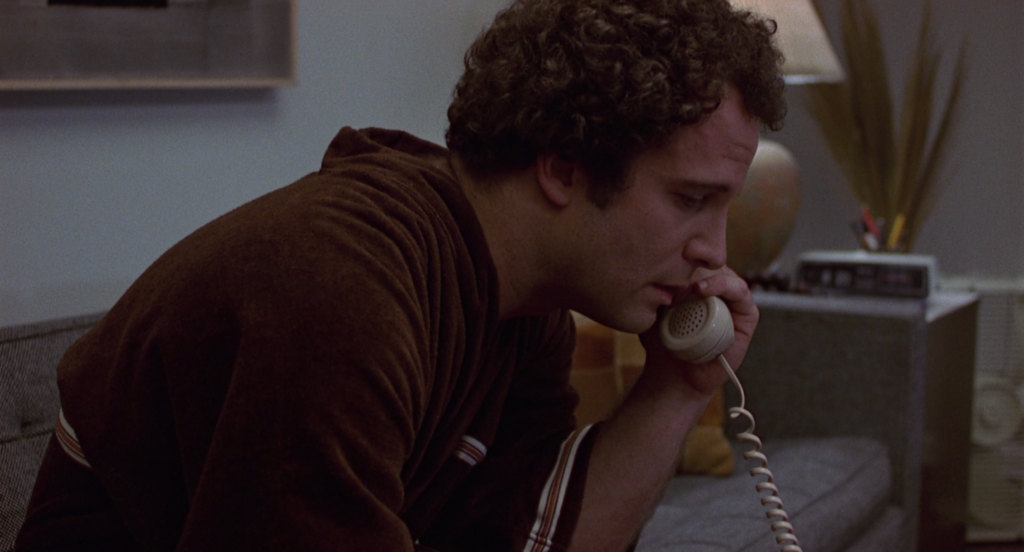
Albert Brooks makes one of numerous ill-advised phone calls in “Modern Romance” (1981).
Finally, I was happy to rewatch the Albert Brooks classic Modern Romance (1981) thanks to Indicator’s HD release. Brooks plays Robert Cole, a film editor (at American International Pictures!) working on a cheesy science fiction epic with his co-editor Jay (Bruno Kirby, City Slickers) while failing to completely break up with his on-again, off-again girlfriend Mary (Brooks’ girlfriend at the time, Kathryn Harrold). Written with Brooks’ longtime writing partner Monica Johnson, the result is not the rom-com you might expect from the pink-hued poster showing Brooks and Harrold snuggling, or the credits’ use of Joe Cocker’s slow-dancer “You are So Beautiful” (strictly ironic here). The film begins with Robert breaking up with Mary at dinner, and then expressing disbelief that she won’t stay to eat. He takes Quaaludes and makes a date over the phone with a random name from his Rolodex while barely conscious. He keeps calling Mary. He takes his date on a drive around the block and drops her off again, telling her it’s a bad time for him right now. He works on the science fiction film (starring George Kennedy) and deals with the unfortunate artistic impulses of its mild-mannered director (James L. Brooks). He gets talked into buying an accessories-heavy athletic ensemble because he wants to start a running regimen (the deadpan salesman is Brooks’ brother, Bob Einstein, aka Super Dave Osborne – and it might be the film’s funniest scene). He keeps calling Mary. He aggressively courts her and wins her back. From there, things go badly, or at least just as well as they have been. Brooks is a satirist first and foremost, and one reason that his films have aged so well is that his characters, so frequently deluded narcissists (I’d cite the excellent Defending Your Life as an exception), are the butt of the joke more than half the time. Without Brooks, I’m not sure we’d have Curb Your Enthusiasm or The Office. Like his follow-up, Lost in America (1985), the comedy often arises from his lame justifications for obsessive, destructive, abhorrent behavior. There’s a reason he’s calling Mary when he told her he wouldn’t. It’s fate that she didn’t pick up. It’s fate that she did pick up this time, but that he didn’t say anything to her. There’s a reason he’s sneaking a look at her phone bill, hidden in a drawer (he was shaving and looking for a razor), and anyone would subsequently call that long distance number to find out who’s on the other end. And then disguise their voice. And then bring up the bill and ask about the call first thing on a romantic weekend getaway. If that’s not caring for your partner’s needs, what is?









